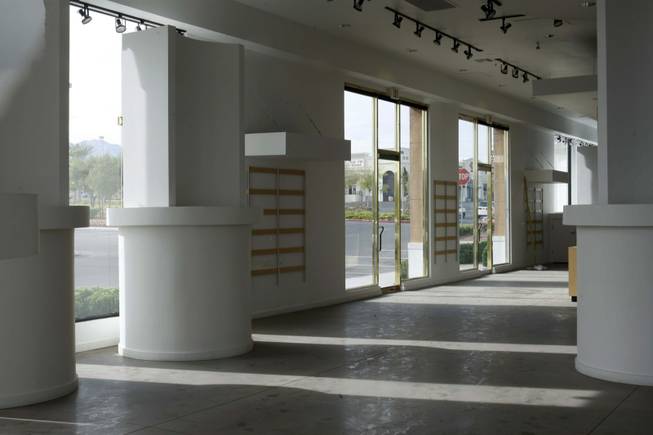
A vacant store is shown at the Grand Canyon Center retail mall near Interstate 215 and West Flamingo Road.
Friday, April 17, 2009 | 2 a.m.
Sun archives
- Las Vegas braces for commercial foreclosures (4-17-09)
- Report: 25% of LV commercial real estate troubled (4-3-09)
- L.A. commercial property market to slow in ‘09 (3-17-09)
- Expert: Some residential lots have virtually no value (2-27-09)
- At shopping plazas, anchors aweigh (1-28-09)
- Businesses struggling to hang on (11-24-08)
Sun topics
With no end to the current economic woes and retail vacancy rates rising, landlords are looking for creative ways to attract new tenants and keep the ones they have.
“A lot of our clients are offering, generally speaking, whatever they have to do to get a lease signed,” said Rob Moore, managing director of investment sales and leasing for Gatski Commercial Real Estate Service.
Gatski Commercial is a Las Vegas-based company that provides property management, leasing, brokerage, landscaping and maintenance services for is clients.
In recent years the challenge had been to find space for retailers, but that has changed.
A recent report by Marcus & Millichap Real Estate Investment Services indicates the retail vacancy rate in Las Vegas will rise to more than 10 percent this year and rents are expected to slip 3.6 percent. There are at least 40 anchor spaces vacant in the Las Vegas area, and with several national retailers struggling to stay afloat, that number could go even higher.
Retailers with money to invest can write their own ticket right now, but there are limits to what can be offered, even in tough economic times.
There comes a time, Moore said, when there are so many concessions to get a tenant that it might be better to leave a space vacant.
The problem with that strategy is that an empty store, especially if it is a big box or anchor space that drives traffic, can affect the other retailers on a property.
It’s a delicate balancing act that has forced shopping center owners to look for short-term solutions that could pay dividends when the economy recovers.
Moore cited the example of an owner with a vacant anchor spot who is offering two years of free rent on a two-year lease for a first-to-the-market tenant.
“He knew it was not leasable in this market,” Moore said. “His hope was that a big-box user would come here and pay CAMs (common area maintenance fees) and in two years maybe sign a 10-year lease.”
There is little downside for the owner, Moore said, because in this market the space would likely remain vacant for two years anyway. By having a tenant in the space, there is a traffic driver for the other merchants, the risk of vandalism of the vacant space is eliminated and the tenant might even add stores in other locations later.
Although free rent is an attractive draw, it does not guarantee occupancy. There are not a lot of retailers looking to expand into new markets right now, and the costs associated with such a move can be significant.
In addition to the maintenance fees, a retailer has to give the space a signature look and train employees. Establishing a presence in a new market, especially a competitive retail environment such as Las Vegas, would also require a significant amount of advertising and promotion.
Still, a retailer ready to make the move into what has traditionally been a strong retail market can get a pretty good deal now.
There are also potential deals to be made for existing retailers, especially if a lease is about to expire.
The last thing a property manager or shopping center owner wants is to lose a tenant, and retailers with a solid history in a location have a strong bargaining position.
Mike Powell, president of Nevada-based Port of Subs, said a franchisee recently negotiated with his landlord to get a portion of a remodel and new exterior signage paid for in exchange for signing a new lease.
“His lease was up and he needed some improvements,” Powell said. “He had been a good tenant and the landlord did not want to lose him, so they worked out a deal.”
Except for the Strip, which caters primarily to tourists, the Las Vegas Valley has been underserved with retail for years. Landlords held all the cards, and tenants were lining up for the limited retail space.
Just when developers began to recognize the potential value of retail projects and started building in areas with high population growth, the economy soured and the region was left with a glut of empty or half-filled strip malls.
Shopping center owners and property managers are now in a situation where property values have diminished at the same time there is less demand for retail space.
“It is a renter’s market and landlords are reaching for deals more so than in the past,” said Scot Marker, senior vice president of the retail division of Colliers International’s local office.
Colliers International is a global affiliation of independently owned real estate services firms. It provides local information as well as a global perspective on market trends.
“What it comes down to is that landlords are still not going to make bad deals,” Marker said.
Although that may be true, many are still willing to make deals they would not have even considered a few years ago and retailers now have a few more cards to play.


Join the Discussion:
Check this out for a full explanation of our conversion to the LiveFyre commenting system and instructions on how to sign up for an account.
Full comments policy